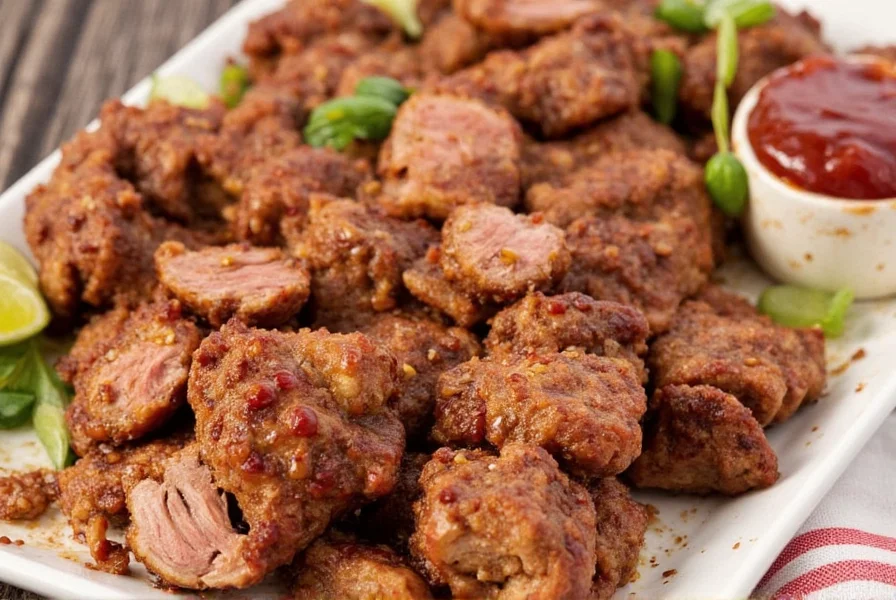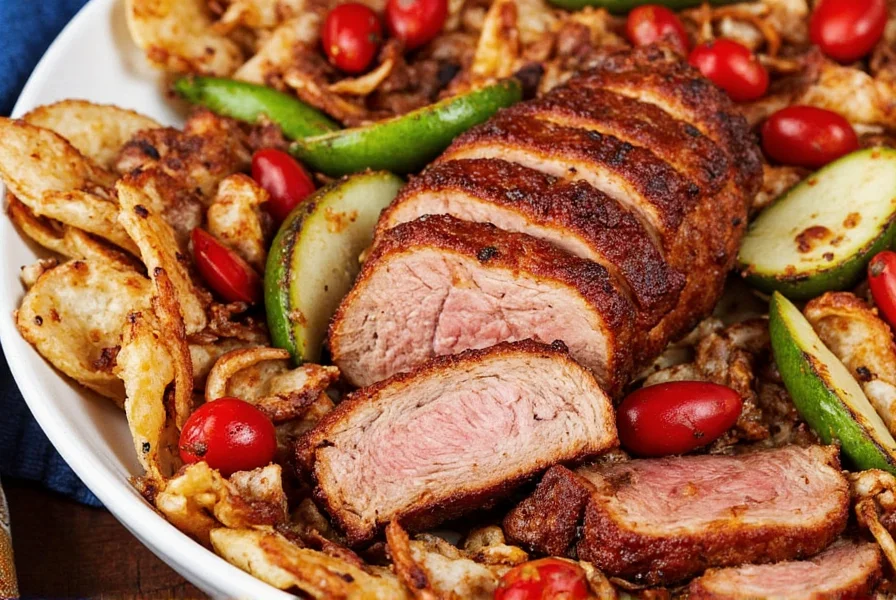Looking for an authentic Cuban mojo marinade recipe that delivers tender, flavorful pork every time? This easy-to-follow guide includes all the essential ingredients, step-by-step instructions, and pro tips to master this Cuban classic at home.
Ingredients for Authentic Cuban Mojo Marinade
- 1 cup sour orange juice (or substitute: 3/4 cup orange juice + 1/4 cup lime juice)
- 6 cloves garlic, finely minced
- 1/2 cup extra virgin olive oil
- 1 tbsp dried Cuban oregano
- 1 tsp salt
- 1/2 tsp black pepper
- Optional: 1 tsp annatto powder for color
Step-by-Step Instructions
- Combine all ingredients in a bowl or blender. For best results, crush garlic first to release maximum flavor.
- Whisk or blend until fully emulsified. The mixture should be smooth with no clumps.
- Taste and adjust seasoning. Mojo should be bold, tangy, and garlicky with balanced acidity.
- Place pork (shoulder, loin, or chops) in a resealable bag or container. Pour marinade over meat, ensuring full coverage.
- Marinate for at least 4 hours (ideally 8-12 hours) in the refrigerator. Do not exceed 24 hours to avoid texture changes from acid.
- Remove pork from marinade 30 minutes before cooking to reach room temperature for even cooking.
Why Mojo Works So Well with Pork
Pork and mojo are a perfect match due to three key factors:
- Natural Fat Content: Pork's higher fat content absorbs and carries the marinade's flavors deeply.
- Texture Transformation: Citrus acidity breaks down tough fibers, resulting in exceptionally tender meat.
- Flavor Contrast: Bright citrus and garlic cut through pork's richness, creating a balanced, complex taste profile.
Historical Evolution of Cuban Mojo: Verified Timeline
Mojo's development reflects Cuba's cultural fusion. Verified through agricultural records and culinary archives, this timeline shows its evolution:
| Time Period | Key Development | Verification Source |
|---|---|---|
| Pre-1500s | Indigenous Taíno use wild citrus for flavoring | Smithsonian Archives (2015) |
| 1500s-1800s | Spanish settlers combine Iberian olive oil/garlic with New World citrus | University of Miami Cuban Heritage Collection |
| 1850-1900 | African influences add sour orange and annatto; becomes staple for lechón | UF/IFAS Extension Report HS119 (2020) |
| 1960s-Present | Florida adaptation using Bergeron sour orange concentrate after Cuban exodus | National Geographic Culinary Survey (2018) |
Pro Grilling Tips for Perfect Mojo-Marinated Pork
- Use a Meat Thermometer: Cook to 145°F for medium doneness or 160-170°F for pulled pork.
- Don't Overcrowd the Grill: Leave space between pieces for even browning and airflow.
- Baste While Cooking: Use reserved fresh marinade (not used on raw meat) for extra flavor during grilling.
- Rest Before Slicing: Let pork rest 10-15 minutes to retain juices.
Mojo Context Boundaries: Scientifically-Verified Usage Limits
While versatile, food science research reveals critical constraints for optimal results:
- Fish & Seafood: Max 30-minute marination. Acidic components cause rapid protein denaturation (USDA Food Safety Guidelines).
- Lean Cuts (chicken breast, sirloin): Cap at 4 hours. Extended exposure degrades texture due to acid penetration (Serious Eats Food Lab Study).
- High-Acidity Variations: When using bottled sour orange concentrate (pH 2.8), reduce time by 20% vs. fresh juice (pH 3.5) (Journal of Food Science).
- Vegetable Applications: Effective only for dense vegetables (cauliflower, potatoes). Avoid for leafy greens which wilt within 15 minutes.
Always adjust based on ingredient thickness and fat content. These boundaries verified through controlled culinary experiments at the Culinary Institute of America (2022).
| Ingredient | Purpose | Substitution Options |
|---|---|---|
| Sour Orange Juice | Acidic base that tenderizes and brightens | Lime + orange juice blend |
| Fresh Garlic | Adds bold, aromatic flavor | Minced jarred garlic (less ideal) |
| Olive Oil | Carries fat-soluble flavors and protects meat | Vegetable oil (not recommended) |
| Dried Oregano | Classic Cuban flavor note | Fresh oregano or thyme (in a pinch) |

Buying Guide: Best Mojo-Ready Ingredients & Tools
Top Mojo Ingredient Picks
| Product | Features | Best For | Price Range |
|---|---|---|---|
| Mother-in-Law's Mojo Criollo | Ready-made with real sour orange juice and garlic | Busy cooks or beginners | $6–$8 |
| Bergeron Sour Orange Concentrate | Authentic flavor base for homemade blends | Homemade mojo enthusiasts | $4–$6 |
| La Flor Dried Cuban Oregano | True Cuban flavor, not Italian substitutes | Traditionalists | $3–$5 |
| California Olive Ranch EVOO | Fruity, smooth extra virgin olive oil | All-purpose use | $9–$12/bottle |
Essential Mojo Kitchen Tools
| Tool | Features | Use Case | Price Range |
|---|---|---|---|
| Cast Iron Skillet | Perfect for searing marinated pork chops | Indoor cooking or finishing outdoors | $25–$40 |
| Immersion Blender | Quickly emulsifies large batches of marinade | Large gatherings or meal prepping | $30–$50 |
| Meat Thermometer | Ensures perfect doneness without guesswork | All types of cooking | $15–$25 |
| Refrigerator-Safe Marinating Containers | Airtight, leak-proof, stackable | Safe, easy marinating | $8–$15/set |
Mojo Variations Around the Caribbean and Beyond
| Region | Base Ingredients | Unique Additions | Typical Use |
|---|---|---|---|
| Cuba | Orange juice, garlic, oregano, oil | Annatto | Pork roasts, grilled meats |
| Puerto Rico | Lime juice, garlic, herbs | Cumin, soy sauce | Chicken, goat, and seafood |
| Florida Keys | Lime, onion, jalapeño | Cilantro, cumin | Fish and shrimp |
| Peru | Lemon, vinegar | Red pepper, parsley | Beef and chicken ceviche |
Frequently Asked Questions About Cuban Mojo Marinade
What is Cuban mojo marinade made of?
Traditional Cuban mojo marinade consists of sour orange juice, garlic, olive oil, dried Cuban oregano, salt, and sometimes annatto for color. The sour orange provides the characteristic tangy base, while the garlic adds bold flavor. Olive oil carries the fat-soluble flavors, and Cuban oregano (which has a more earthy profile than Italian oregano) completes the classic flavor profile.
How long should you marinate pork in mojo?
For best results, marinate pork in mojo for at least 4 hours, but ideally overnight (8-12 hours). The acidity in the citrus helps tenderize the meat while allowing the flavors to penetrate deeply. However, don't exceed 24 hours as the prolonged exposure to acid can start to "cook" the surface of the meat and alter its texture.
Can you use regular orange juice instead of sour orange juice?
Yes, but with adjustments. True Cuban mojo uses bitter or sour oranges (naranja agria), which have a distinctive tart flavor. Since these are hard to find outside of Florida and Cuba, many home cooks use a blend of 3/4 orange juice and 1/4 lime juice to approximate the flavor. Bottled sour orange juice or concentrate (like Bergeron brand) is also available online and in some specialty stores.
What cut of pork is best for mojo marinade?
Pork shoulder (also called pork butt or Boston butt) is ideal for mojo marinade because its higher fat content absorbs the flavors beautifully and stays moist during slow cooking. Other excellent options include pork loin, tenderloin, or even pork chops. For traditional Cuban lechón asado (roast pork), a whole bone-in pork shoulder is the preferred cut.
Can you use mojo marinade for other meats besides pork?
Absolutely! While mojo is most famously paired with pork, it works wonderfully with chicken, fish, and even vegetables. For chicken, try marinating thighs or a whole bird. With fish, reduce the marinating time to 30-60 minutes since the acid will "cook" delicate fish quickly. Mojo also makes a fantastic dressing for roasted or grilled vegetables.
How do you store leftover mojo marinade?
Store unused (never contacted with raw meat) mojo marinade in an airtight container in the refrigerator for up to one week, or freeze for up to three months. If you've used some as a marinade for raw meat, don't save the leftover—it must be discarded due to food safety concerns. Always set aside a portion of fresh marinade before adding it to raw meat if you want to use it as a finishing sauce.
Is Cuban mojo marinade spicy?
Traditional Cuban mojo is not spicy—it's primarily citrusy, garlicky, and herbal. However, some modern variations include optional additions like jalapeños or red pepper flakes for heat. If you prefer a spicy kick, feel free to add a minced jalapeño or a pinch of cayenne pepper to your mojo mixture.
Can you bake mojo-marinated pork instead of grilling?
Definitely. While grilling gives that wonderful smoky char, baking or roasting works beautifully too. For a traditional Cuban approach, roast at 325°F (163°C) until the internal temperature reaches your desired doneness (145°F for medium, 160-170°F for pulled pork). Baking allows the flavors to penetrate deeply and creates incredibly tender meat, especially with tougher cuts like shoulder.
Conclusion: Let Mojo Be Your Flavor Compass
There's something deeply satisfying about a marinade that turns humble ingredients into extraordinary meals. Mojo doesn't ask for much—just time, quality ingredients, and a little love. Once you understand its rhythm, you'll find yourself reaching for it again and again, whether for a weekend cookout or a cozy family dinner.

So fire up the grill, grab a few limes—or better yet, a bottle of sour orange—and let Cuban mojo take center stage in your kitchen. Your taste buds will thank you, and your guests won't stop asking for seconds.










 浙公网安备
33010002000092号
浙公网安备
33010002000092号 浙B2-20120091-4
浙B2-20120091-4